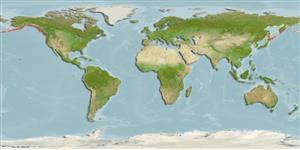>
Perciformes/Cottoidei (Sculpins) >
Cottidae (Sculpins)
Etymology: Clinocottus: Greek, klinein, kline = sloping and bed, due to the four apophyses of sphenoid bone + Greek, kottos = a kind of fish (Ref. 45335).
More on author: Gilbert.
Environment: milieu / climate zone / depth range / distribution range
Ökologie
seewasser; süßwasser; brackwasser demersal; tiefenbereich 0 - 20 m (Ref. 96339). Temperate; 66°N - 34°N
Eastern Pacific: Bering Sea coast of Alaska to Big Sur River, central California, USA.
Size / Gewicht / Alter
Maturity: Lm ? range ? - ? cm
Max length : 6.4 cm TL Männchen/unbestimmt; (Ref. 2850); common length : 4.4 cm TL Männchen/unbestimmt; (Ref. 12193)
Kurzbeschreibung
Bestimmungsschlüssel | Morphologie | Morphometrie
Rückenflossenstacheln (insgesamt) : 7 - 9; Rückenflossenweichstrahlen (insgesamt) : 14 - 16; Afterflossenstacheln: 0; Afterflossenweichstrahlen: 10 - 13; Wirbelzahl: 32 - 33. Distinguished by the flattened tripartite anal papilla and the cirri on the eyeballs, head, lateral line and at the tip of each dorsal spine (Ref. 27547). Gill rakers reduced to low smooth mounds; lateral line high toward the head, curving downward to middle of sides, straight toward the tail, each of the anterior 15 or so pores having a slender cirrus (Ref. 27547). Next to the last anal ray longer than the rays before and behind it; pectorals reach to or just beyond front of anal fin; caudal rounded (Ref. 6885, 27547). Color varies with the environment, sometimes nearly uniform bright green but more often green to light brown above with dark wedge-shaped saddles, broader below, on upper part of sides, with lighter color between; sometimes, along or below lateral line, a dark longitudinal stripe that is in some cases interrupted with light spots; ventral region creamy to white; three dark lines radiating from the eye, the first to the snout, another downward to behind the mouth, the third rearward to base of preopercular spine; spiny dorsal with a dark blotch between first and third spine; pelvic fins plain, others usually dusky, mottled or indistinctly barred (Ref. 27547).
Facultative air-breathing in the genus (Ref. 126274); Commonly found in rocky intertidal and subtidal areas, but also over sand and in eelgrass and seaweeds (Ref. 2850). May leave tide pools if aquatic conditions become inhospitable (Ref. 31184). Occasionally enters fresh water (Ref. 27547). Probably feeds on small invertebrates common among seaweed and in tide pools. Breathes air when out of water (Ref. 31184).
Eschmeyer, W.N., E.S. Herald and H. Hammann, 1983. A field guide to Pacific coast fishes of North America. Boston (MA, USA): Houghton Mifflin Company. xii+336 p. (Ref. 2850)
IUCN Rote Liste Status (Ref. 130435)
Bedrohung für Menschen
Harmless
Nutzung durch Menschen
Fischereien: nicht kommerziell
Tools
Zusatzinformationen
Download XML
Internet Quellen
Estimates based on models
Preferred temperature (Ref.
123201): 4.6 - 12.8, mean 7.1 °C (based on 597 cells).
Phylogenetic diversity index (Ref.
82804): PD
50 = 0.5312 [Uniqueness, from 0.5 = low to 2.0 = high].
Bayesian length-weight: a=0.00676 (0.00300 - 0.01523), b=3.17 (2.98 - 3.36), in cm total length, based on LWR estimates for this (Sub)family-body shape (Ref.
93245).
Trophic level (Ref.
69278): 3.5 ±0.37 se; based on food items.
Widerstandsfähigkeit (Ref.
120179): hoch, Verdopplung der Population dauert weniger als 15 Monate. (Preliminary K or Fecundity.).
Fishing Vulnerability (Ref.
59153): Low vulnerability (10 of 100).
